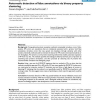Free Online Productivity Tools
i2Speak
i2Symbol
i2OCR
iTex2Img
iWeb2Print
iWeb2Shot
i2Type
iPdf2Split
iPdf2Merge
i2Bopomofo
i2Arabic
i2Style
i2Image
i2PDF
iLatex2Rtf
Sci2ools
BMCBI
2005
2005
Automatic detection of false annotations via binary property clustering
Background: Computational protein annotation methods occasionally introduce errors. Falsepositive (FP) errors are annotations that are mistakenly associated with a protein. Such false annotations introduce errors that may spread into databases through similarity with other proteins. Generally, methods used to minimize the chance for FPs result in decreased sensitivity or low throughput. We present a novel protein-clustering method that enables automatic separation of FP from true hits. The method quantifies the biological similarity between pairs of proteins by examining each protein's annotations, and then proceeds by clustering sets of proteins that received similar annotation into biological groups. Results: Using a test set of all PROSITE signatures that are marked as FPs, we show that the method successfully separates FPs in 69% of the 327 test cases supplied by PROSITE. Furthermore, we constructed an extensive random FP simulation test and show a high degree of success in d...
| Added | 15 Dec 2010 |
| Updated | 15 Dec 2010 |
| Type | Journal |
| Year | 2005 |
| Where | BMCBI |
| Authors | Noam Kaplan, Michal Linial |
Comments (0)

